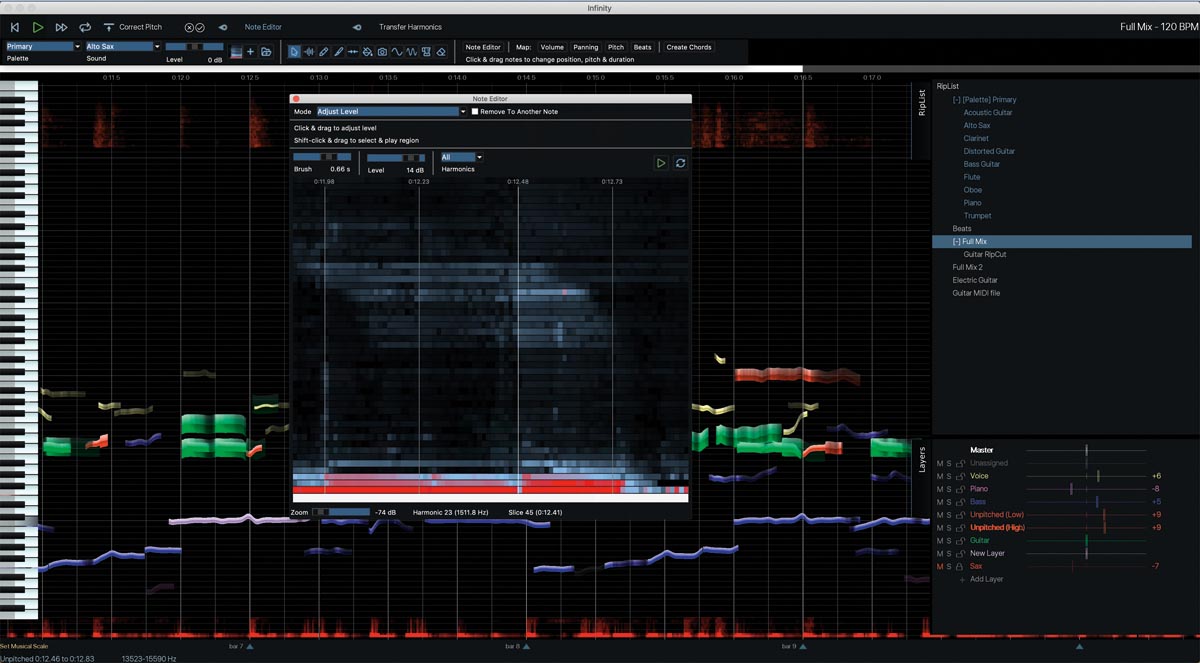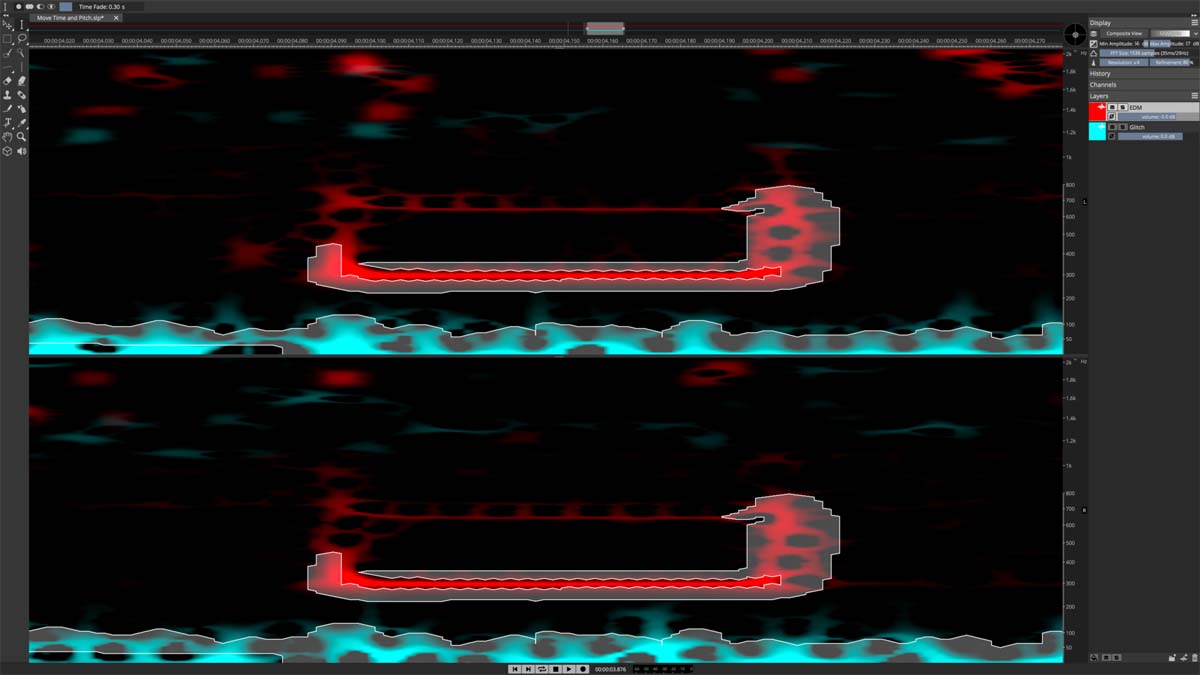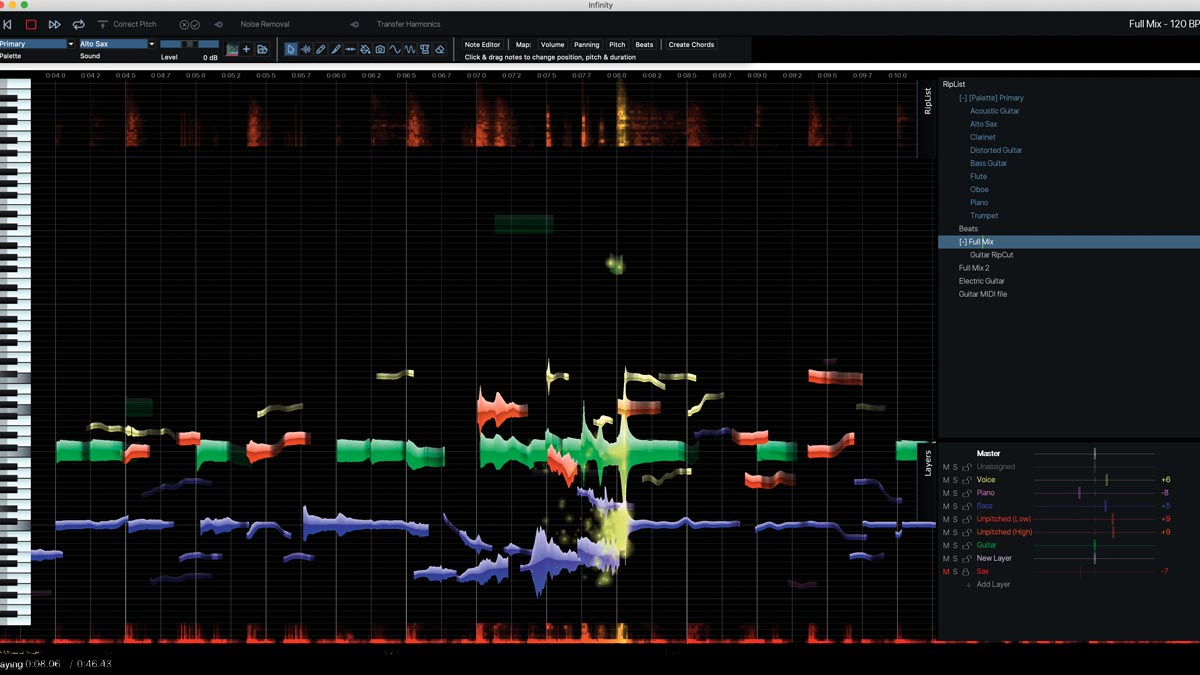MusicRadar Verdict
Performs impressive functional and creative tasks… but it would still benefit from a slicker user interface.
Pros
- +
Unique mix of editing tools.
- +
Many options for editing individual pitched elements inside an audio file.
- +
Simple timeline/layers-based workflow.
Cons
- -
Accurately extracting specific instruments can take time.
- -
Expensive
MusicRadar's got your back
What is it?
In the decade since Hit’n’Mix’s audio software first appeared, it has come on leaps and bounds and not only grown in terms of features but also sounds a whole lot better.
Somewhere along the way it acquired the Infinity name and now, at version 4.7, could finally be ready for a much wider audience.
Billed as the world’s first atomic audio editor, Infinity is a standalone application (OS X 10.10 or later, Windows 7 or later) that analyses audio (WAV, mp3, Flac, Ogg) and presents it as melodic and noise components. These can be edited in various ways to achieve functional, reparation and creative tasks.
Melodic and noise components appear in a typical timeline workspace with pitch/frequency on the y-axis and time on the x-axis. Infinity uses a layers-based workflow, and once it’s finished analysing an audio file, presents what it calls a ‘Rip’ as two noise elements, Unpitched (Low) and Unpitched (High), and as many melodic Layers as it sees fit.
Note Editor lets you paint, erase, smooth and adjust different types of harmonics across selected notes
You’ll find these listed in the fold-out Layers panel on the right-hand side, and this includes other layer-specific functionality such as mute, solo, note lock, playback level, rename, delete and duplicate as well as various visual options such as colour and width. You can edit notes directly in the workspace and apply a number of real-time changes including volume and pitch correction via the dropdown Effects menu.
Further destructive processing is accessed via the RipScripts menu. Finally, there’s also a Sound Palette feature to draw notes from scratch.
Infinity’s initial analysis is CPU intensive (our 4 core i7 took about four mins per minute of mixed audio). How it separates the file is also quite important.
Want all the hottest music and gear news, reviews, deals, features and more, direct to your inbox? Sign up here.
A simple monophonic sound will be presented as a single melodic Layer with two noise Layers, whereas complex audio files will have more melodic Layers, and we’ll look at the implications of this later. Infinity also uses a user-editable script-based system for much of its editing and processing functions.

What can it do?
Infinity lets you modify the pitch, amplitude, timing and harmonic content of the analysed audio. Pitch editing is assisted by an optional keyboard scale on the left and you can also define and snap to a specific key scale, which is handy.
There are various pitch options that flatten, shift, quantise and slide the selected notes, and deeper functions to harmonise and add vibrato. Script-based options add more complex tasks including pitch redrawing of existing notes, pitch cloning between notes, pitch mapping over time and chord creation.
For note timing, you can move and stretch notes and sections of notes can be cut, copied and pasted. You can modify overall timing by adding tempo changes or map individual timing changes across groups of notes.
Note volumes also support a number of realtime and script-based changes including mapping. The fact you’re editing audio here but with the facility of a MIDI editor can’t be overemphasised.
There’s quite a steep learning curve, though this is considerably improved by the interactive help option
If you want to edit the unpitched aspects of the audio such as percussive attacks, thumps and high-frequency voice noises (t, sh, s and so on) you can simply solo the two unpitched Layers.
However, for an overall view, Audioshop’s ‘Edit Unpitched’ uses the whole workspace, making it much easier to zone in on specific frequencies. It also includes a nifty threshold-based Noise Removal script.
As we said, Infinity can also edit harmonic content, which comes into its own within the Note Editor option. This script-based editor lets you paint, erase, smooth and adjust different types of harmonics across the selected notes. From a creative perspective, it’s hugely powerful.
Finally, note that Infinity can import and export MIDI files and for the latter, this means conversion of your audio to MIDI note data.

Performance and verdict
As mentioned, Infinity splits mixed audio into a number of different Layers. Unfortunately, for complex tracks, these often combine different instruments, which makes extracting a specific sound or quickly modifying just one instrument quite difficult. It’s not totally impossible to resolve as you can move notes between Layers, but this can be time-consuming.
Next up, there’s no getting around the fact that when you pull apart the sonic components that form a mix, the isolated sounds can be pretty unusual. This is fine if you just want to make changes within a mix, but if you’re looking to extract a pristine vocal from a full mix, it’s less successful.

• Steinberg SpectraLayers Pro 6
SpectraLayer’s manipulation and editing of audio files can achieve some impressive results.
• Celemony Melodyne Editor
For pitch manipulation of both monophonic and polyphonic sources, Melodyne is hard to beat.
Also, from a user perspective, it’s very easy to make multiple changes and find yourself some distance from your original audio. It, therefore, pays to save copies of your edited Rips as you go, and we found duplicating individual Layers also helped if we wanted to A/B different changes.
There’s also a reasonably steep learning curve, though this is considerably improved by the interactive help option.
All told, Infinity is a very powerful application that can be a little clunky to use. That said, it offers the sort of depth that appeals to audio creatives, and the fact that you can repair and redesign your audio files all under one roof makes it a pretty unique application that will repay the time you invest in it.
MusicRadar verdict: Performs impressive functional and creative tasks… but it would still benefit from a slicker user interface.
The web says
"Once you've ripped a track, you can move individual notes in both pitch and time in whatever way you fancy. You can change the chords, change the modes, transpose, fix timing issues, copy/paste, shorten and lengthen the notes... and we haven't opened a single menu yet! There's so much going on within Infinity that it's difficult to explain it all and not get distracted by one element when there are so many other things to talk about."
Sound On Sound
Hands-on demos
Sound On Sound
Hit'n'Mix
Specifications
- Type: Audio editor
- Key features: Remix, Repair andRedesign audio files, plus edit audio in video (video Mac only); easily edit audio as notes, harmonics & unpitched sound, using high-quality, polyphonic source separation; Replace instruments or any sound, plus repitch and clone notes within audio & MIDI tracks, and more
- System requirements: Mac OS X 10.10 or later, Windows 7 or later
- Contact: Hit'n'Mix
Computer Music magazine is the world’s best selling publication dedicated solely to making great music with your Mac or PC computer. Each issue it brings its lucky readers the best in cutting-edge tutorials, need-to-know, expert software reviews and even all the tools you actually need to make great music today, courtesy of our legendary CM Plugin Suite.

